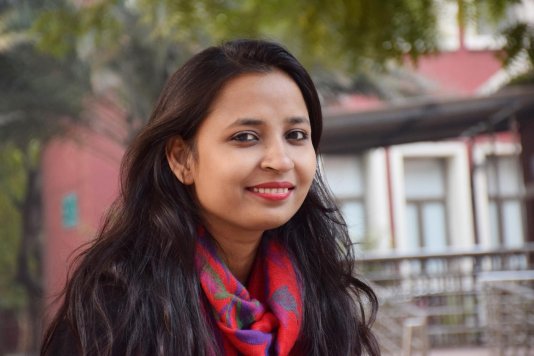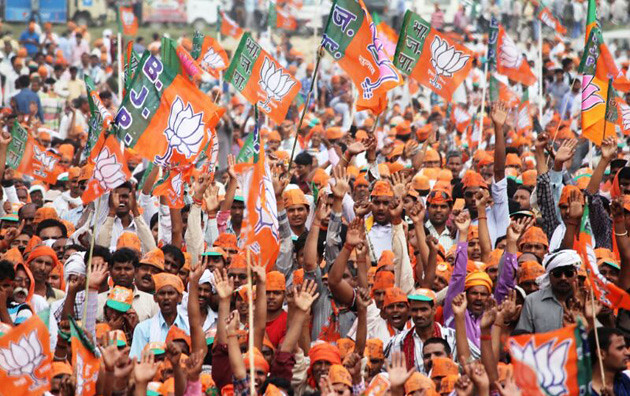- About
- Topics
- Picks
- Audio
- Story
- In-Depth
- Opinion
- News
- Donate
-
Signup for our newsletterOur Editors' Best Picks.Send
Read, Debate: Engage.
| October 06, 2022 | |
|---|---|
| topic: | Discrimination |
| tags: | #India, #Dalit, #Bahujan, #caste-system, #discrimination, #journalism, #media |
| located: | India |
| by: | Shruti Agarwal |
The incident of a nine year old Dalit boy from Rajasthan’s Jalore district being beaten to death by his school teacher last August for allegedly touching a pot of water meant for upper castes is only the latest caste controversy to take the country by storm.
The caste system, a hierarchy which placed the Shudras (labourers) and Untouchables (sweepers, cleaners) at the bottom of the ladder, has organised India's social, political and economic structure for 3,000 years. Despite constitutional outlawing of the system, caste differences persist and have been re-inscribed in Indian society in a myriad ways.
Not only is inter-caste marriage still considered taboo, poverty levels, social mobility and access to education continue to be structured through this hierarchy. Dalits (formerly untouchables), Bahujans and Adivasis (indigenous communities), apart from being socially excluded, are also targets of rising casteist violence.
A 2020 report claims an average of 10 rape cases targeting Dalit women take place each day, while the actual number may depend on the extent of (under)reporting.
In the aftermath of the Jalore, Rajasthan incident, many mainstream news organisations, such as The Indian Express, The Hindustan Times, India Today, reported on it primarily from the viewpoint of whether or not the boy’s beating was ‘caste-driven.’
This has become an issue as a 2019 survey by Oxfam India and Newslaundry revealed that despite the fact that the upper castes forms only about 20 percent of India’s population, it dominates 88 percent of leadership positions in newsrooms, 95 percent of all reporting in English language newspapers and 90 percent of all reporting in Hindi language newspapers.
This had cast doubt on the impartiality of Indian mainstream media’s reporting on caste-related incidents.
Meena Kotwal, the founding editor of 'The Mooknayak' is part of an emerging alternative media dedicated to covering caste atrocities with nuance, while also covering neglected issues concerning India's marginalised.
The Mooknayak has recently been awarded the Human Rights and Religious Freedom Journalism Award and the Excellence in Journalism Award 2022 by the Ambedkar Association of North America (AANA), among others.
The establishment of Bahujan (an umbrella term for people belonging to lower castes) media outlets, human rights advocates point out, is an important development in tackling India's segregated media landscape.
FairPlanet: What was the inspiration behind launching the Mooknayak? Can you talk a little about your journey so far?
Meena Kotwal: I’m the first person in my family to have received an education. My family earned a living as mazdoors (labourers) and I didn't know people who could guide me through what subjects I could choose, what careers I could aim for.
In a conversation with some friends, it came up that I could try for a news anchoring position. At the time, all I knew of journalism was the anchors we used to see on TV screens. At Jamia University, I found out what journalism really was and grew passionate about reporting.
After three years in Jamia and my postgraduate studies at IIMC (Indian Institute of Mass Communication), I started working for National Dastak (a web channel founded in 2015 focusing on marginalised issues in India). While working there, it became clear to me, after hearing so many of the same stories among Bahujan journalist circles, that mainstream media had no space for Dalits.
There isn’t a single Dalit editor in mainstream India media today, and there is plenty of data showing this.
This skewed composition of Indian newsrooms is a result of both overt discrimination rooted in upper caste biases of lower caste people lacking ‘merit’, as well as more subtle forms of ostracisation based on the differences in certain social markers (such as English pronunciation, ways of dressing and dietary preferences).
Tejas Harad, a scholar and journalist, has documented the isolation, othering and discrimination faced by lower caste journalists in Indian media. He highlights how Dalit journalists are often on the receiving end of derogatory comments, have their story ideas rejected without explanation (while similar stories from upper caste journalists are rarely if ever rejected) and are typecast as reporters fit to cover only caste-related incidents.
Meena Kotwal: Journalism didn’t seem like much of an option anymore, there was no space for people like me, and so, I decided to take the academic route.
I applied for an M.Phil program at Ambedkar Central University and got accepted. Around the same time, BBC had some new positions open, and they were looking for a younger crop of reporters. I wasn’t going to apply, but my partner insisted that I should try, and that their coverage was more progressive, so I likely wouldn't have to face the kind of working environment I’d experienced previously. I applied without any expectations, but got accepted.
This seemed like a new leaf to me. BBC was a big deal, and most reporters I knew would want to work for them. I worked there for two years, and it wasn’t long before I was made to feel like I didn’t belong there. My stories would be rejected without reason, my pitches would not get approved, while people who had joined at the same time as me didn’t face the same issues in getting their ideas approved.
Our office had a policy of ‘criticising each others’ work in private and exchanging praise in public,’ and I was the only person who received the opposite treatment. I was often publicly scolded by my supervisors, and when people felt the need to apologise for something they did, they did it in private.
The office environment was starting to get overwhelming. I became depressed and suicidal, started losing a lot of weight, and didn’t have the nerve to go to the office anymore. But I didn’t resign, I wanted to see how long they could keep this up until they fired me. They ended up giving me a notice period.
After that I worked for many different places, including The Wire, The Print and others, but none of them were willing to hire me full-time and preferred a freelance arrangement. Finally, I started my own news website. I wanted to name it after Babasaheb’s publication, 'Mooknayak.' [“Mooknayak”, meaning “voice of the voiceless” was a newspaper established by Bhimrao Ambedkar, who was a social reformer and played a prominent role in drafting India’s constitution].
Initially, I was concerned about copyright issues, but as it turned out, all of Babasaheb's possessions and works were open for anyone to use. He had never claimed that they belonged only to him.
What would you say are the biggest problems with the way mainstream media covers caste issues?
When the mainstream media covers caste, they do it in a very self-preserving way. The reason being that the people in the editorial and decision-making posts all belong to similar castes, have similar priorities. When covering caste, they shy away from even the bare minimum so that it doesn’t reflect badly on them.
Look at the Hathras incident, for example. Initially, only non mainstream and relatively small media organisations and YouTube channels were covering it, before the mainstream media jumped into the conversation when the event started gaining traction. By then, the rape victim had already died, and it was too late.
After entering the conversation, most mainstream media houses tried to distort the conversation. The victim's family were made out to be naxalites [a term commonly used in Indian politics to discredit dissenters as ‘anti-national’ or ‘far-left radicals’]. And that was not the only accusation flung at them in an attempt to de-link the rape from its casteist origins. The rapists have still not been found guilty, and the muddling of facts in such cases adds to the problem.
It has been two years since Hathras, but I want to talk about a more recent case in Jalore where a Dalit boy - for simply touching a pot of water - was beaten up so badly by a teacher that he died from the injuries. When the mainstream media entered this conversation, there was an outpouring of reports implying that there was no water pot in the first place.
So I have to ask: why is the mainstream media so quick to brush aside casteist motivations? If indeed there was no water pot, why did the conversation devolve so quickly into whether or not there was a caste angle rather than investigating the details of what would motivate a teacher to behave this way?
Plainly put, they try not to bring up caste, but when the engagement generated by organisations like ours and smaller YouTube channels politicises and visibilises a matter enough, they end up joining the conversation, and the engagement is usually one of distortion and evasion.
"Why is the mainstream media so quick to brush aside casteist motivations?"
Media watchdog ‘Newslaundry’ has documented Indian mainstream media's misreporting of the Hathras incident, where four upper caste men raped a Dalit girl. Channels, including Aaj Tak and News18, tried to turn the case into a conspiracy theory, using tactics such as putting out false information that ‘the victim did not mention caste,’ citing incorrect information alleging that the rape didn’t take place and claiming that the victims’ family were naxalites, to name a few.
The Dainik Jagran went as far as claiming that the victim’s family was responsible for her death. A research article on the matter also highlights the one-sidedness of such reporting. In the Hathras case, for example, the Thakur caste, to which the perpetrators belonged, have a history of inflicting violence on lower castes. Yet, they were never a subject of media scrutiny and most reporters interviewed the victim’s community, but stayed away from interviewing, questioning or discussing the dominant caste.
How important would you say climate issues are to your coverage, considering it is the lower caste people who are bearing the brunt of the climate crisis? Can you tell us a little bit about the environment desk at The Mooknayak?
When the floods come, it is those on the margins who have the most to lose: their houses and their lives. We try to cover issues that aren’t ordinarily the topic of conversation, so these are the things we want to start conversations about.
As for an environment desk, we don’t have a designated one; we’re still in our early years. Right now, we are trying to train new reporters and support them to pick up the skills for on-the-ground reporting.
The recent UP assembly elections were the first elections The Mooknayak covered on the ground. Can you talk about how The Mookanayak has evolved and what are some of the challenges that come with it?
One challenge is that, right now, we are relying solely on crowd-funding, since we would rather not give up editorial control to secure political funding.
Most news organisations have certain political affiliations, but we do not. Governments have come and gone, but caste has stayed and thrived regardless.
We work for the communities that want to be heard. So many people who read our work and want us to carry on support us, often with sums like fifty or hundred rupees (USD $0.62 or $1.23) because that is all they can manage.
When a disenfranchised area like Baliya gets electricity supply as a result of our coverage, those are the kinds of results we focus on, rather than trying to change the bigger things.
Picture by Charl Folscher
By copying the embed code below, you agree to adhere to our republishing guidelines.

